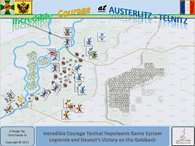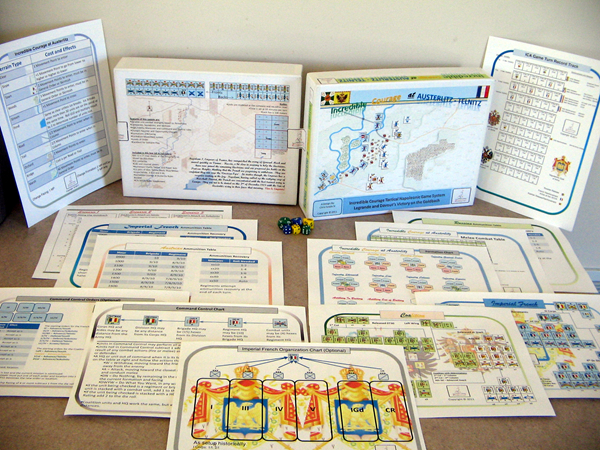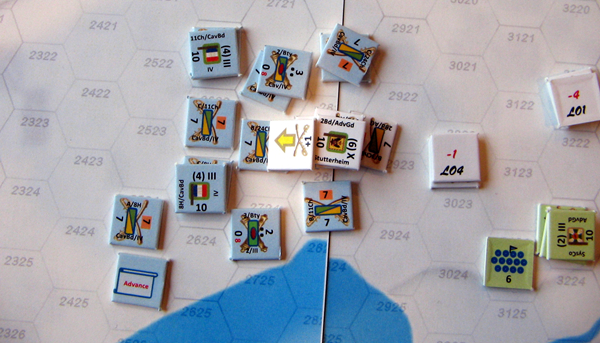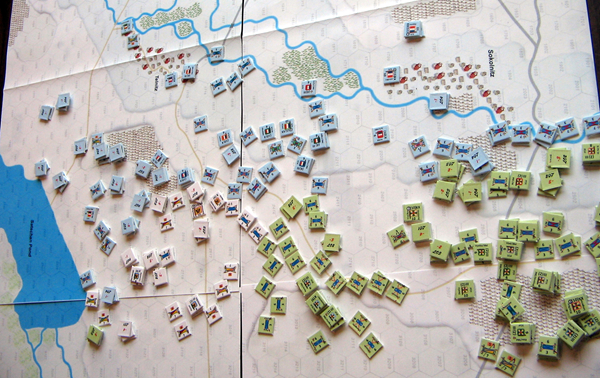Incredible Courage at Austerlitz-Telnitz – Board Game Review
 Incredible Courage at Austerlitz – Telnitz. Boardgame Review. Publisher: Grognard Simulations, Inc. Designer: Chris Fasulo, Sr. $75
Incredible Courage at Austerlitz – Telnitz. Boardgame Review. Publisher: Grognard Simulations, Inc. Designer: Chris Fasulo, Sr. $75
Passed Inspection: Handsome map and counters. Nicely suited for solitaire play. A tactical look at the challenges of Napoleonic warfare.
Failed Basic: More examples needed. Needs larger hexes and counters. Major time commitment needed to play.
It’s always exciting to see a game released from a new company. Therefore, when Incredible Courage at Austerlitz-Telnitz arrived on my desk for review, I was ecstatic. I had never heard of Grognard Simulations Inc. so I immediately went to their website to research the company. The company president and head game designer, Chris Fasulo, Sr., is not only an avid game player but also has military experience as a Scout Platoon Leader in a tank battalion and as a military trainer for OPFOR. From this, we can assume that Grognard’s releases will be very accurate military simulations.
{default}Incredible Courage at Austerlitz-Telnitz is a tactical simulation covering the southern third of 1805’s Battle of Austerlitz. Grognard’s Fasulo told me that the maps, counters and rule additions are already done for the next two parts of this gaming trilogy. When all three games are laid out map to map, the complete tactical experience will need 7 to 8 feet worth of table to play!
This battle was fought by Napoleon’s Imperial French forces against Russian and Austrian troops. Napoleon and his commanders through cunning tactics (including the opportunistic use of movement while hidden by heavy fog), superior French training and “élan” and well-thought-out lines of supply managed to defeat the numerically superior Coalition forces. Defeated, the Austrians sued for peace while the Russians withdrew and plotted their revenge.

Behold, the many components in this game!
Each unit is made up of from 50 to 150 men and is either a command unit, cavalry, infantry, Pioneers, Grenadiers, or artillery. Some units represent dispatch riders who carry orders from command posts to the troops. Each unit is rated for such aspects as combat strength, movement, range (for artillery), and leadership ratings. The counters are colorful but the printing is rather small. Counters are also provided to keep track of formations (skirmish, square, etc.), levels of order, charge actions and orders.
Melee, charging and fire attacks degrade the units’ level of order. Each subtraction affects the units’ ability to attack and defend. When the level of order for a unit reaches 1, it must retreat and try to regroup. If it can’t retreat or an attack takes the level of order below zero, the unit is eliminated. If a unit is pushed too hard, this can also result in a loss of levels of order.
Levels of order can be regained by units each turn and a key to this game is knowing when to withdraw units so that they can regroup before they hit level 1. The astute player will constantly be shifting fresh units to the front while pulling tired units back. In addition, the player can roll to re-form ‘destroyed’ units from stragglers.

Leadership is another important factor in the game. Since each hex is only 100 meters, it’s not very difficult to keep your headquarters and subsidiary commanders within their listed lines of communication. If a unit is out of communication with its commanders, it may ignore orders, wander in an undesired direction or just stop and do nothing but react to attacks.
Most units are double-sided – one side being their stats in line formation, the other their stats in column formation. My French forces decimated a Russian formation that was attempting to outflank the defenders of the town of Sokolnitz. The Russians were using column formations to make speed towards Telnitz and ran right into French cannons placed high on a hill. Then from behind the hill marched infantry in line formation. The entire Russian advance was halted as the columns of troops tried to shift in to a more efficient fighting formation.
The rules are only 14 pages long, with most of that being made up of designer notes, tactics and background. They are efficiently presented but could use examples. There were no examples of combat, movement, etc. at all in the game. The rest of the rules are represented by over a dozen card stock charts – many of which are double-sided. Charts included cover organizational charts for all sides, command control tables, terrain effects, Melee and fire combat tables, ammunition availability tables for each nation as well as “Adjustable Strength Tables” for each nation.
The Adjustable Strength Tables are interesting in that each turn the players roll for their country’s army to see how efficient the troops are at Fire, Infantry Melee and Cavalry Melee for each of five different formations. This represents a fascinating fog of war which simulates the uncertainty of dealing with masses of men all dependent on the efficient communicating of orders by officers and NCOs.
The game includes three scenarios – two covering half the battle on this southern wing and one covering the whole battle on the southern wing. The whole battle consists of 66 turns, each representing 10 minutes. Each turn is detailed for ground fog, reinforcements, and units released from static positions.
The game includes an amazing level of detail. but this detail and tactical focus can be a bane as well as a boon. It took me around two hours to set up all the units (there are over 18 sheets of counters included) and then another seven hours to play through 22 turns of the 66 turn game. This is not a “light” game and takes a lengthy time commitment to play in its entirety. The short rules may make it look like a “beer and pretzels” game; it is anything but.

The game could also have benefited by an index and the box should list an average playing time. Also, the organization of rules – some in the book, some on the charts – can slow down the game as the players try and figure out where the rule actually is.
Another aspect that can drag out the game is that each unit is supposed to attack separately – no adding together of combat strengths. This may work in a small-unit tactical game with, perhaps, 30 units on the board, but in a game with hundreds of counters, this can make one turn last for over an hour! In a game with 66 turns, this dramatically drags out the game.
I also wish that the counters and hexes were a little bigger. I had trouble putting level of order counters on the units and then removing them without knocking stacks of units out of whack. The maps are slick so the units can jump all over the terrain.
All in all, Incredible Courage at Austerlitz-Telnitz, is an engaging tactical study of Napoleonic warfare but is not a game for those lacking in time and patience. I am anxiously awaiting more games from Grognard Simulations.
Armchair General Rating: 87 %
Solitaire Rating (1-5): 4 (Very Good)
About the Author
A college film instructor and small business owner, Richard Martin has also worked in the legal and real estate professions, is involved in video production, film criticism, sports shooting and is an avid World War I and II gamer who can remember war games which came in plastic bags and cost $2.99 (he’s really that old)!

